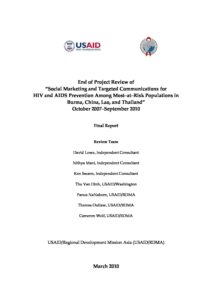Abstract
This report details findings of an end of project assessment of the implementation of USAID/RDMA’s cooperative agreement with PSI for ‘Social marketing for STI/HIV prevention among high risk groups in the Mekong region, FY08‐FY10. The project is funded over a three period, with allocations by country as follows – Burma: HIV $3.6 m, TB $1 m; China: $2.6 m; Lao: $1 m; and Thailand: $0.2 m.
The strategic goal of the project is to reduce the spread of HIV and STI among most at risk populations (MARPs) including female sex workers (FSW) and their clients, injecting drug users (IDU), and men who have sex with men (MSM), including transgenders (TG). The project’s main objective is to increase access to the Comprehensive Package of Services (CPS) by MARPS. Key achievements in relation to the project’s intermediate objectives are as follows:
Objective 1: Increase access to prevention interventions for MARPs
All of the MARPs targeted by PSI are hard to reach because of social marginalization and all have relatively high rates of HIV, although this varies by MARP and geographic location. PSI’s programs in each country have resulted in significantly increased access to prevention interventions by MARPs. Depth of penetration in accessing MARPs has been high.
PSI’s social marketing activities have significantly grown the size of the condom markets and established condom buying habits among MARPs and others. Since 2007, sales and free distribution of condoms and lubricant to MARPs, their partners and the general population have continued to grow significantly. PSI recognizes the need to encourage new private sector entrants into the condom market, (which is occurring in Lao), to ensure long term sustainability, whilst ensuring that affordable condoms are available to the poor and most vulnerable.
Periodic behavioral surveys conducted by PSI in each country found evidence of positive behavior change in the most at risk populations targeted. These outcomes include higher levels of condom use and consistent condom use among MSM and FSW, and in China decreased sharing of needles and syringes among IDU. PSI behavioral data for most MARPs indicates that statistically significant levels of behavior change are achieved when MARPs are exposed to more elements of the comprehensive prevention package. This ‘dosage’ effect confirms that the comprehensive prevention package approach is both appropriate and needed.
Increased safe behavior by MARPs may contribute to the program’s strategic goal of reducing the spread of HIV and STIs among MARPS. However, there is insufficient data at this point in time to demonstrate whether this higher level impact is being achieved by PSI.
Objective 2: Increase access to care and support for PLHA
PSI’s promotion and provision of VCT services has increased access to HIV testing, enabling MARPs to know their HIV status and be referred to care, support and treatment services. However, the uptake of HIV counseling and testing is quite low, and most MARPs do not know their HIV status. PSI promotion and provision of STI diagnostic and treatment services for MARPs has increased access to client‐friendly STI services. As with VCT, the uptake of STI clinical services has generally been low. This points to the need to address demand side issues as well as supply side issues. The introduction of rapid testing for VCT significantly increased VCT uptake among MARPs in China and Lao. PSI’s social marketing of pre‐packaged, branded STI treatment kits through DiCs and the private sector has increased MARP access to appropriate and quality treatment regimens at an affordable price.
USAID support for PSI/Burma’s TB program has increased access to free TB treatment on a national scale, with a focus on the poor. However, integration of HIV and TB has been limited as only a minority of TB cases are having HIV tests due to policy settings which limit the places where HIV testing can be performed.
Access by HIV positive MARPs to care, support and treatment services provided by PSI’s partner organizations has been limited in some countries, particularly Burma, because of the small number of treatment places available. In high prevalence settings, PSI increased its focus on the care and support needs of PLHA. While there are linkages with care, support and treatment services, the capacity of all programs to ensure a seamless continuum of prevention to care, support and treatment has been insufficient.
Objective 3: Increase access to strategic information
PSI’s strong emphasis on strategic information highlights the value the organization places on evidence‐based programming; quality assurance methods are built into its data collection systems; good internal capacity has been built; and the results of research are turned into program action. Areas where performance has been mixed are in using strategic information for advocacy on policy change and program issues at the national and sub‐national levels; more regular sharing and dissemination of results to external partners; and greater involvement of MARP communities in evidence‐based decision making.



